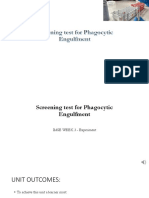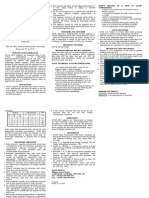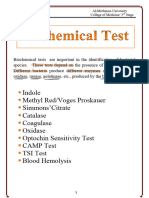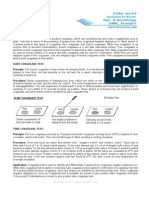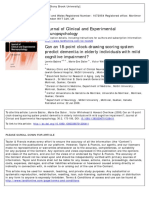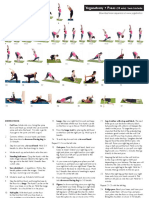Instrucciones Coagulasa
Instrucciones Coagulasa
Uploaded by
shealockCopyright:
Available Formats
Instrucciones Coagulasa
Instrucciones Coagulasa
Uploaded by
shealockOriginal Description:
Original Title
Copyright
Available Formats
Share this document
Did you find this document useful?
Is this content inappropriate?
Copyright:
Available Formats
Instrucciones Coagulasa
Instrucciones Coagulasa
Uploaded by
shealockCopyright:
Available Formats
Bactident Coagulase
For the detection of the enzyme coagulase developed by staphylococcus aureus.
Bactident Coagulase
Mode of Action
Coagulase is an enzyme with the ability to coagulate plasma.
Staphylococcus aureus forms two types of coagulase. The free
coagulase is an extracellular enzyme, the bound coagulase is
localized on the surface of the cell wall. Both enzymes are
detected in the tube test. With the slide test, only the bound
coagulase can be detected.
If the test is negative after 4-6 hours, continue incubating the
tube and make a final assessment after 24hours. For the
negative control, prepare a brain-heart broth, but do not
inoculate. There must be no sign of clotting.
For the positive control, conduct the test with a coagulasepositive strain of staphylococcus.
Method
negative
no coagulation
An overnight broth culture of staph. aureus is incubated with
rehydrated EDTA-rabbit plasma. The coagulase test is positive, if
more than three quarters of the tube contents forms a coherent
clot.
1 + positive
a few small separate clots
2 + positive
a few small joined clots
3 + positive
large extensively coagulated clots
Stability
4 + positive
complete coagulation, contents do not shift
when tube is inverted
See expiry date.
Bactident Coagulase is stable for 5 days in the dissolved
(rehydrated) condition at +2C to +8C. At -20C it is stable for
up to 30 days.
Storage
Store cool, dry and tightly closed at +2C to +8C. Store
dissolved plasma at +2C to +8 C or deepfrozen at -20C. Do
not refreeze once defrozen.
Notes
The slide test in which a colony is mixed with rabbit plasma on
a microscope slide (clumping factor), only detects the bound
coagulase and can at best only service as a screening test. Falsepositive reactions and autoagglutination can occur.
Ordering Information
Safe Disposal
Product
Merck Cat. No.
The contents of the tube include bacteria and must be disposed
of safely. This can be done by autoclaving or placement in a
5-6% solution of disinfectant for at least 6hours.
Pack
contents
Bactident Coagulase
1.13306.0001
6 vials each
containing
3ml of
lyophilized
rabbit plasma
with EDTA
Experimental Procedure
a. Conduct the coagulase test on 5 typical and/or 5 a-typical
colonies on BAIRD-PARKER agar (Merck Cat. No. 1.05406.)
or 5 suspect colonies from other culture media (CHAPMAN
agar, Merck Cat. No. 1.05469., VOGEL-JOHNSON agar,
Merck Cat. No. 1.05405., Blood agar (base), Merck Cat. No.
1.10886.).
b. Transfer each of the selected colonies with a sterile
inoculation loop to separate culture tubes containing brainheart broth (Merck Cat. No. 1.10493.) and incubate at 37C
for 20-24 hours.
c. Dissolve the freeze-dried EDTA-rabbit plasma in 3ml of
distilled or demineralized water.
d. Pipette 0.3ml of the rehydrated Bactident Coagulase into a
sterile culture tube using a sterile pipette.
e. Carefully mix 0.1ml of the brain-heart broth culture 1/2 an
inoculation loop of colony material from the CHAPMAN
blood or BAIRD-PARKER agar with the 0.3ml of plasma and
incubate in a water bath at 37 C. (Colony material directly
from VOGEL-JOHNSON or mannitol-sodium chloride-phenol red agar is not suitable for the test. A brain-heart broth
culture is required first.).
f. Every hour, check the tube contents for coagulation by
gently tipping to the side (not by shaking).
g. The coagulase test is positive, if more than three quarters of
the tube contents has formed a coherent clot.
Merck Microbiology Manual 12th Edition
179
You might also like
- Elution and Adsorption TechniquesDocument23 pagesElution and Adsorption TechniquesBromance H.No ratings yet
- EXPT3-IMSELAB-Screening Test For Phagocytic EngulfmentDocument21 pagesEXPT3-IMSELAB-Screening Test For Phagocytic EngulfmentJulie Ann GarceraNo ratings yet
- Endangered Species of Plants & Animals in MaharashtraDocument18 pagesEndangered Species of Plants & Animals in Maharashtra27 Hardik Gosavi82% (17)
- Final Sop Manual-1-1Document62 pagesFinal Sop Manual-1-1Dianne JoyNo ratings yet
- Automotive Functional Safety Best-Practices - ISO 26262 Standard - EmbitelDocument5 pagesAutomotive Functional Safety Best-Practices - ISO 26262 Standard - Embitelprasanna_npNo ratings yet
- Team PRTC Mas-Finpb - 5.21Document12 pagesTeam PRTC Mas-Finpb - 5.21NananananaNo ratings yet
- Coagulase PlasmaDocument2 pagesCoagulase PlasmaHà Anh Minh LêNo ratings yet
- All Staph TestsDocument33 pagesAll Staph Testsalhaitham alqmeNo ratings yet
- Biochemical TestDocument12 pagesBiochemical TestPrativa RajbhandariNo ratings yet
- Coagulase Plasma (Bactident Coagulase)Document10 pagesCoagulase Plasma (Bactident Coagulase)Verika AstrianaNo ratings yet
- Diagnostic Microbiology Manual PDFDocument31 pagesDiagnostic Microbiology Manual PDFmajdi bilbisiNo ratings yet
- PL850 Rabbit-Coagulase-Plasma EnglishDocument2 pagesPL850 Rabbit-Coagulase-Plasma Englishzahramaulidi28No ratings yet
- Biochemical Test of BacteriaDocument26 pagesBiochemical Test of BacteriaazizahNo ratings yet
- II) Coagulase Test: ProcedureDocument4 pagesII) Coagulase Test: ProcedureMd Ahsanul HaqueNo ratings yet
- BIOCHEMICAL TESTS - PPTX MLSDocument111 pagesBIOCHEMICAL TESTS - PPTX MLSyewollolijfikreNo ratings yet
- Coombs TestDocument17 pagesCoombs Testnativeman2221No ratings yet
- Catalase Test 112552Document15 pagesCatalase Test 112552amar pritulNo ratings yet
- Sop For StaphDocument6 pagesSop For StaphLala SaadNo ratings yet
- Reference LabDocument545 pagesReference LabphamthanhbeubooneNo ratings yet
- Laboratory # 3 Biochemical Differentiation of Some Medically ImportantDocument34 pagesLaboratory # 3 Biochemical Differentiation of Some Medically ImportantSirine AjourNo ratings yet
- CogulaseDocument2 pagesCogulaseilyas9558No ratings yet
- 43 Hahhu E01Document8 pages43 Hahhu E01Cao Thi Le ChiNo ratings yet
- Chapt 8Document22 pagesChapt 8Elaine LaczaNo ratings yet
- Discussion: Staphylococcus Can Be Pathogenic and Less Pathogenic or Non Pathogenic. ToDocument2 pagesDiscussion: Staphylococcus Can Be Pathogenic and Less Pathogenic or Non Pathogenic. Tokaren leeNo ratings yet
- lecture counting of Staphylococcus aureusDocument16 pageslecture counting of Staphylococcus aureusmarwanehab292No ratings yet
- Ifobt Single Package InsertDocument4 pagesIfobt Single Package InsertDevi OktaviannyNo ratings yet
- Biochemical TestDocument43 pagesBiochemical TestKrittika ChatterjeeNo ratings yet
- IFU Pruebas Embarazo Placa MonlabtestDocument8 pagesIFU Pruebas Embarazo Placa MonlabtestAna RivasNo ratings yet
- Blood TypingDocument2 pagesBlood TypingDahr ELNo ratings yet
- Lab.5 Biochemical Test-1Document13 pagesLab.5 Biochemical Test-1zainab6112003No ratings yet
- Coagulase TestDocument9 pagesCoagulase Testabalidu91No ratings yet
- The Antiglobulin Test (Coomb's Test) Direct & Indirect: Group 1Document23 pagesThe Antiglobulin Test (Coomb's Test) Direct & Indirect: Group 1Marj Mendez100% (1)
- Canine IgG InsertDocument2 pagesCanine IgG InsertGomatheeswariNo ratings yet
- I) Catalase Test Materials Required:: Cultures: Media: ReagentDocument4 pagesI) Catalase Test Materials Required:: Cultures: Media: ReagentMd Ahsanul HaqueNo ratings yet
- T.GAL packinsert finalDocument4 pagesT.GAL packinsert finalpetertrungNo ratings yet
- CoagulaseDocument2 pagesCoagulaseJiki LaluNo ratings yet
- SPECIMEN COLLECTION AND TRANSPORT - ADocument8 pagesSPECIMEN COLLECTION AND TRANSPORT - AJane Frances JabricaNo ratings yet
- 212 Antibody Detection Test Saline Method1Document4 pages212 Antibody Detection Test Saline Method1Alfreah Jean TambasenNo ratings yet
- Technical Data Sheet: Chromocult® TBX (Tryptone Bile X Glucuronide) Aagar Acc. Iso 16649Document6 pagesTechnical Data Sheet: Chromocult® TBX (Tryptone Bile X Glucuronide) Aagar Acc. Iso 16649Wahyu NugrahaNo ratings yet
- Food Microbiology Analysis - Lab ManualDocument33 pagesFood Microbiology Analysis - Lab Manualbachngon1412No ratings yet
- Biochemical Tests and Culture Media PDF+AsperigillusDocument242 pagesBiochemical Tests and Culture Media PDF+AsperigillusOSAMA BAKHIT100% (1)
- Laboratory 7-9Document3 pagesLaboratory 7-9JOSENo ratings yet
- Week 3 - Topic 1 - Demonstration of Characteristics, Lab Diagnosis & Pathogenesis of StaphylococcusDocument24 pagesWeek 3 - Topic 1 - Demonstration of Characteristics, Lab Diagnosis & Pathogenesis of StaphylococcusTayyaba TahiraNo ratings yet
- Accudiag™ Toxocara Igg Elisa Kit: Test PrincipleDocument3 pagesAccudiag™ Toxocara Igg Elisa Kit: Test Principletuấn anhNo ratings yet
- Widal TestDocument11 pagesWidal TestlialestariNo ratings yet
- Pastorex Strepto GroupDocument3 pagesPastorex Strepto GroupEnrique Duarte100% (1)
- Canine Adipocytokine Zinc Alpha 2 Glycoprotein (ZAG) Elisa KitDocument13 pagesCanine Adipocytokine Zinc Alpha 2 Glycoprotein (ZAG) Elisa KitMihael DraksicNo ratings yet
- Chapter Three Final 7th JanDocument4 pagesChapter Three Final 7th JanMaryam MainasaraNo ratings yet
- Anti-Human GlobulinDocument7 pagesAnti-Human GlobulinDominic EmerencianaNo ratings yet
- Biochemical TestDocument30 pagesBiochemical Testgarlicgarlic23No ratings yet
- Elk0855 1Document17 pagesElk0855 1Thamer Ahmed ObeidatNo ratings yet
- Handling and Processing of Blood Specimens For Laboratory Testing Group 1Document5 pagesHandling and Processing of Blood Specimens For Laboratory Testing Group 1Hanna Kristel Joy CayogyogNo ratings yet
- 2.SOP for AHG-1Document6 pages2.SOP for AHG-1abiyot jemberNo ratings yet
- Manual ANA ElisaDocument10 pagesManual ANA ElisaDaniel Mojica VegaNo ratings yet
- Clinical Microscopy - PregnancyDocument36 pagesClinical Microscopy - PregnancymarielleNo ratings yet
- Laboratory Methods - BAM - I - Staphylococcus Aureus - IDocument5 pagesLaboratory Methods - BAM - I - Staphylococcus Aureus - IoktaNo ratings yet
- 88004D - Oray - Paper - Veritas Collagen Matrix Safety StudiesDocument11 pages88004D - Oray - Paper - Veritas Collagen Matrix Safety StudiesscribdNo ratings yet
- FAQ2Document11 pagesFAQ2Abhinav ChakrabortyNo ratings yet
- Praktikum 3Document24 pagesPraktikum 3ALFEARA YUNIARNo ratings yet
- Column Agglutination Technology: The Antiglobulin Test: Agglutination of Red CellsDocument5 pagesColumn Agglutination Technology: The Antiglobulin Test: Agglutination of Red CellsOB3 Ortho Clinical DiagnosticsNo ratings yet
- Roche GlucoseDocument4 pagesRoche GlucoseDiep LeNo ratings yet
- Methods For Preclinical Evaluation of Bioactive Natural ProductsFrom EverandMethods For Preclinical Evaluation of Bioactive Natural ProductsNo ratings yet
- Jadual KENAIKAN GAJI 2012 01012012xlsDocument87 pagesJadual KENAIKAN GAJI 2012 01012012xlsدايڠ ازرينNo ratings yet
- 3 s2.0 B9781455748013003301 MainDocument120 pages3 s2.0 B9781455748013003301 MainInzamam Ul HaqNo ratings yet
- NCM 119module 2Document19 pagesNCM 119module 2MitchelleNo ratings yet
- Impact of Rainfall On Agricultural Production in Bihar: A Zone-Wise AnalysisDocument7 pagesImpact of Rainfall On Agricultural Production in Bihar: A Zone-Wise AnalysisSahooNo ratings yet
- Lesson 6 Slides - The Rankine Power Cycle PDFDocument18 pagesLesson 6 Slides - The Rankine Power Cycle PDFPheza AndrewNo ratings yet
- Olefin Metathesis: Robert H. GrubbsDocument24 pagesOlefin Metathesis: Robert H. GrubbsTiago Breve da SilvaNo ratings yet
- Ewiv11D3Osgug Parts List: Fill Here!Document8 pagesEwiv11D3Osgug Parts List: Fill Here!Carmen Adriana Garcia MendozaNo ratings yet
- Denture Base MaterialsDocument65 pagesDenture Base MaterialsGitanjali Sharma33% (3)
- Framework For Testing Performance For Hand Dishwashing Detergents Version 22.06.2016Document3 pagesFramework For Testing Performance For Hand Dishwashing Detergents Version 22.06.2016Shaun RimosNo ratings yet
- ECON311 Analysis 5Document5 pagesECON311 Analysis 5Ryota kiseNo ratings yet
- Ug Rock FallDocument1 pageUg Rock FallMika PrameswariNo ratings yet
- Guide To Inclined Plate SettlersDocument15 pagesGuide To Inclined Plate SettlerspapadafiNo ratings yet
- Weatherford Ampscot Pumping Units Parts ListDocument4 pagesWeatherford Ampscot Pumping Units Parts ListAndrea VarasNo ratings yet
- REC Alpha Pure 405WDocument2 pagesREC Alpha Pure 405WbehrendmpNo ratings yet
- MSDS - Silicon SprayDocument10 pagesMSDS - Silicon SprayadminNo ratings yet
- Date Palm Waste Gasification in Downdraft GasifierDocument7 pagesDate Palm Waste Gasification in Downdraft GasifiersumitrochakrabortiNo ratings yet
- Teste Do Relogio Cotação de BabinsDocument15 pagesTeste Do Relogio Cotação de BabinsAndreiaNo ratings yet
- Nutri-Serve Wellness NewsletterDocument2 pagesNutri-Serve Wellness NewsletterSMSTECHNo ratings yet
- 2009년 12월 종로모의고사 (고1) - 답안Document5 pages2009년 12월 종로모의고사 (고1) - 답안Mingu JeongNo ratings yet
- P8008HVA: Dual N-Channel Enhancement Mode MOSFETDocument5 pagesP8008HVA: Dual N-Channel Enhancement Mode MOSFETEsther AsturiasNo ratings yet
- Screenshot 2022-12-07 at 12.14.41 PMDocument2 pagesScreenshot 2022-12-07 at 12.14.41 PMEkbal AllamNo ratings yet
- Free Fusion Reiki Attunement Leaflet: Who Is Rev Jason Storm?Document5 pagesFree Fusion Reiki Attunement Leaflet: Who Is Rev Jason Storm?Leandro Arce100% (1)
- Madeleine LeiningerDocument2 pagesMadeleine Leiningerdumbwaste528No ratings yet
- Data - Sheet-Non-Shrink Precision Grout 1585-00Document2 pagesData - Sheet-Non-Shrink Precision Grout 1585-00Francis Hiro LedunaNo ratings yet
- Adarsh Management Institute of India: An Iso 9001: 2008 Certified International B-SchoolDocument17 pagesAdarsh Management Institute of India: An Iso 9001: 2008 Certified International B-SchoolAmit TandelNo ratings yet
- Quality Manual For Hydraulically Bound Mixtures PDFDocument18 pagesQuality Manual For Hydraulically Bound Mixtures PDFfizikerNo ratings yet
- P So As SequenceDocument2 pagesP So As SequencethiagomorettiNo ratings yet


